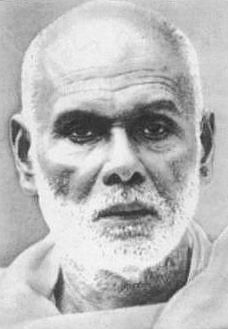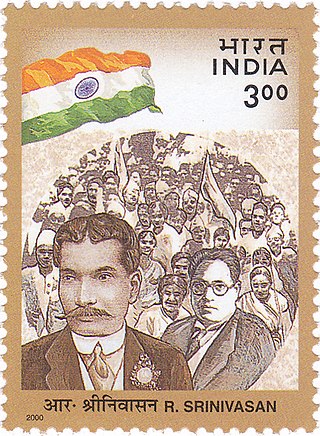
Sree Narayana Guru was a philosopher, spiritual leader and social reformer in India. He led a reform movement against the injustice in the caste-ridden society of Kerala in order to promote spiritual enlightenment and social equality. A quote of his that defined his movement was "one caste, one religion, and one god for all human beings." He is the author of the Advaita poem Daiva Dasakam, which is one of the most used poem in Kerala for community prayer.

Jyotirao Govindrao Phule, also known as Jyotiba Phule, was an Indian social activist, businessman, anti-caste social reformer and writer from Maharashtra. His work extended to many fields, including eradication of untouchability and the caste system and for his efforts in educating women and oppressed caste people. He and his wife, Savitribai Phule, were pioneers of women's education in India. Phule started his first school for girls in 1848 in Pune at Tatyasaheb Bhide's residence or Bhidewada. He, along with his followers, formed the Satyashodhak Samaj to attain equal rights for people from lower castes. People from all religions and castes could become a part of this association which worked for the upliftment of the oppressed classes. Phule is regarded as an important figure in the social reform movement in Maharashtra. The honorific Mahātmā, was first applied to him in 1888 at a special program honoring him in Mumbai.

Dalit is a term first coined by the Indian social reformer Jyotirao Phule for untouchables and outcasts, who represented the lowest stratum of the castes in the Indian subcontinent. Dalits were excluded from the fourfold varna of the caste hierarchy and were seen as forming a fifth varna, also known by the name of Panchama. Several scholars have drawn parallels between Dalits and the Burakumin of Japan, the Baekjeong of Korea and the peasant class of the medieval European feudal system.
The term Dalit Christian or Christian Dalit is used to describe those who have converted to Christianity from other forms of religion in the Indian subcontinent, and are still categorised as Dalits in Hindu, Christian, Muslim, and Sikh societies in South Asia. Hindu Dalits are sometimes referred to as Harijans. About 90% of Pakistani Christians are Dalits from the Chuhra caste and at least 9% of Indian Christians are Dalits, categorised thus by the greater societal practices in various parts of the Indian subcontinent.

Mannathu Padmanabhan was an Indian social reformer and freedom fighter from the south-western state of Kerala. He is recognised as the founder of the Nair Service Society (NSS), which represents the Nair community that constitutes 15.5% of the population of the state. His birthday is observed as Mannam Jayanti every year. Padmanabhan is considered a visionary reformer who organised the Nair community under the NSS.

The Nair Service Society (NSS) is an organisation created for the social advancement and welfare of the Nair community that is found primarily in the state of Kerala in Southern part of India. It was established under the leadership of Mannathu Padmanabha Pillai. The NSS is a three-tier organisation with Karayogams at the base level, Taluk Unions at the intermediate level and a central headquarters operating from Perunna, Changanassery in Kerala. G. Sukumaran Nair is currently the General Secretary.
The PulayarIPA:[pulɐjɐr] is a caste group mostly found in modern-day Indian states of Kerala, Karnataka and historically in Tamil Nadu. They are classified as a Scheduled Caste under India's reservation system in Kerala and Tamil Nadu.
The caste system in Kerala differed from that found in the rest of India. While the Indian caste system generally divided the four-fold Varna division of the society into Brahmins, Kshatriyas, Vaishyas and Shudras, in Kerala, there existed only two varnas: Brahmins and Shudras, out of these four, while others were classified as Avarna. The Malayali Brahmins formed the priestly class. Brahmins labeled all other castes as "Sat-sudra", "Shudra" and "Avarna" based on their origin and ritual rank. The exception to this were Kings in Kerala like of Travancore and Cochin, who were ritually promoted to the status of Kshatriya by means of the Hiranyagarbha ceremony.

Pandit Karuppan was a poet, dramatist, and social reformer who lived in Kerala, India.
The caste system among South Asian Christians often reflects stratification by sect, location, and the caste of their predecessors. There exists evidence to show that Christian individuals have mobility within their respective castes. But, in some cases, social inertia caused by their old traditions and biases against other castes remain, causing caste system to persist among South Asian Christians, to some extent. Christian priests, nuns, Dalits and similar groups are found in India, Pakistan, Bangladesh, and Nepal.

The Ezhavas, also known as Thiyya or Tiyyar in the Malabar region, are a community with origins in the region of India presently known as Kerala, where in the 2010s they constituted about 23% of the population and were reported to be the largest Hindu community. The Malabar Ezhava group has claimed a higher rank in the Hindu caste system than the other Ezhava groups but was considered to be of a similar rank by colonial and subsequent administrations.

T. K. Madhavan Alias Deshabhimani Madhavan, was an Indian social reformer, journalist and revolutionary, who was involved with the Sree Narayana Dharma Paripalana Yogam. He hailed from Kerala and led the struggle against Social discrimination which was known as Vaikom Satyagraha.

Diwan Bahadur Rettamalai Srinivasan, commonly known as R. Srinivasan, was a scheduled caste activist and politician from then Madras Presidency of British India. He is a Paraiyar icon and was a close associate of Mahatma Gandhi and was also an associate of B. R. Ambedkar. He is remembered today as one of the pioneers of the Scheduled caste movement in India. He founded the Adi dravida mahajana sabha in 1893.

Ilavenil Meena Kandasamy is an Indian poet, fiction writer, translator and activist from Chennai, Tamil Nadu, India.
P.K. Chathan Master (1920—1988) was a Communist leader and the first Minister for Local Self Government and Dalits Welfare of the State of Kerala.
Pampady John Joseph (Pampady, 23 May 1887 – 14 July 1940) was a Dalit activist and the founder of the socio-religious movement Cheramar MahajanSabha.
Thycaud Ayyavu Swamikal was a spiritualist and social reformer. He was the first to challenge caste customs in Kerala during a time when caste restrictions and untouchability were at their peak.
Kallumala Samaram (leader-Ayyankali)is an agitation or social revolution by Pulayar community that took place at Perinad and nearby villages such as Cherumoodu, Kanjavely etc. in, Kollam district on 24 October 1915.

The reformation movement in Kerala refers to a socio-cultural shift that began in the late 19th century, resulting in significant transformations in the social fabric of the southern Indian state of Kerala.

N. K. Jose was an Indian historian who was President of the Kerala History Congress known for his studies in Dalit and Christian history in Kerala. Author of over 140 history and social history books, he was given the title Dalit Bandhu by Dalit organizations in 1990 in recognition of his contributions to Dalit studies and Dalit history.












